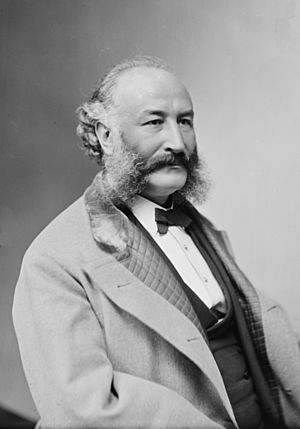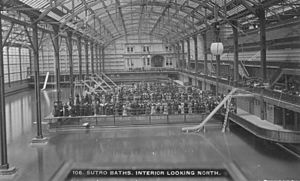Adolph Sutro facts for kids
Quick facts for kids
Adolph Sutro
|
|
|---|---|
 |
|
| 24th Mayor of San Francisco | |
| In office January 7, 1895 – January 3, 1897 |
|
| Preceded by | Levi Richard Ellert |
| Succeeded by | James D. Phelan |
| Personal details | |
| Born |
Adolph Heinrich Joseph Sutro
April 29, 1830 Aachen, Prussia |
| Died | August 8, 1898 (aged 68) San Francisco, California, U.S. |
| Resting place | Home of Peace Cemetery (Colma, California) |
| Political party | People's |
| Profession | Businessman |
Adolph Heinrich Joseph Sutro (April 29, 1830 – August 8, 1898) was an important German-American engineer, politician, and philanthropist. A philanthropist is someone who gives money and time to help others. Sutro served as the 24th mayor of San Francisco from 1895 to 1897.
Born in Germany, he later moved to Virginia City, Nevada. There, he became very wealthy from the silver mines at the Comstock Lode. Many places in San Francisco are named after him. These names remember his life and his many gifts to the city.
Contents
Early Life and Moving to America
Adolph Sutro was born into a Jewish family in Aachen, which was part of Prussia (now Germany). He was the oldest of eleven children. He spent his younger years working in his father's cloth factory and going to school. After his father passed away, he and his brother, Sali, took over the factory.
In 1850, his family left Prussia because of a rebellion. They settled in Baltimore, America. Soon after, Adolph traveled to California. He arrived in San Francisco on November 21, 1851. Adolph worked many different jobs in San Francisco. Eventually, he owned several tobacco shops.
The Sutro Tunnel Project
In 1860, Sutro moved from San Francisco to Virginia City, Nevada. He went there after silver was discovered in the Comstock Lode. He planned to keep selling cigars. But soon, he thought of a big idea: a tunnel to drain water from the mines. This would stop the mines from flooding. This idea became the famous Sutro Tunnel.
In 1865, Sutro started the Sutro Tunnel Company. The U.S. Congress gave him special permission to build the tunnel in 1866. The project faced money problems. A banker named William Ralston first agreed to help pay for it, but then changed his mind. Over time, Sutro found other people to invest, including miners in the area.
Sutro gained the miners' support after a terrible accident at the Yellow Jacket Mine in 1869. This event helped him convince the Miner's Union to support the tunnel. Construction began on October 19, 1869. During the tunnel's building, Sutro himself helped by setting off dynamite blasts. The tunnel was finished in 1878. It made Sutro very rich because it could drain millions of gallons of water daily. Mine owners paid him a lot of money to use it.
After running the tunnel for a year, Adolph moved back to San Francisco. His brother, Theodore Sutro, took over the company. Later, after Adolph's death, Theodore sold the Sutro Tunnel Company.
Sutro's Estate and Public Attractions
Adolph Sutro's wealth grew even more from buying large amounts of land in San Francisco. After returning from the Comstock in 1879, he became a successful businessman and a well-known public figure. His land included Mount Sutro, Land's End (where Lincoln Park and the Cliff House are now), and Mount Davidson.
Sutro was known for his generosity. He opened his own estate to the public. He was seen as a "populist" because he did many kind things for the public. For example, he opened an aquarium. He also built a large and beautiful glass-covered entertainment complex called Sutro Baths in the Sutro District. The Baths opened in 1896. Sutro had worked on this project for years. He tried four times to build sea walls to protect the site from ocean waves. The first three walls were washed away by the Pacific.
In 1896, Adolph Sutro built a new Cliff House. It was a seven-story Victorian building, sometimes called "the Gingerbread Palace." It stood on the cliffs below his estate. This was the same year work started on the famous Sutro Baths. The Baths had six of the biggest indoor swimming pools. There was also a museum, an ice skating rink, and other fun areas. Many people from San Francisco came to visit on Sundays. They arrived by steam trains, bicycles, carts, and horse wagons.
In 1894, Sutro bought many items from Woodward's Gardens. This was a place that had a zoo, amusement park, aquarium, and art gallery. It had closed in 1891. Sutro bought these items to display at the new Cliff House.
The Sutro Baths had both saltwater and springwater pools. They were heated to different temperatures. A concert hall and museums surrounded the pools. These museums were filled with treasures Sutro had collected during his travels and from Woodward's Gardens. The baths became very popular. This was true even though they were far from the main parts of the city. Their popularity was partly because the entry fee was low. Also, Sutro built a special railroad to take visitors there.
Sutro's land investments became much more valuable because of the railroad. The railroad brought many visitors and new development. He also made his land more valuable by planting fast-growing eucalyptus trees on his property at Mount Sutro. This happened when the city also gave tax-free status to "forested" lands within city limits. Small parts of this forest still exist today. The largest part is at Mount Sutro. About 61 acres are owned by the University of California, San Francisco. Another 19 acres belong to the City of San Francisco.
Destruction of the Baths
A fire destroyed the Sutro Baths complex in 1966. Only ruins remain today. The fire was later found to be arson, meaning it was set on purpose. Developers had planned to build apartments there. They took their insurance money and left the property as ruins.
Mayor of San Francisco
Sutro was known for providing fun and culture for everyday people. Because of this, the Populist Party asked him to run for mayor. He won the election by promising to fight against big businesses. He spoke out against the strong control that the Southern Pacific Railroad had over local businesses.
Historian Alexander Saxton noted that Sutro was very popular. He was especially liked by working people. They believed he had defended miners against powerful interests. More recently, he had given many gifts to San Francisco. He was also loved for fighting the Southern Pacific's control over the city's streetcar system. Sutro would have won the election no matter which party he ran for. He won by a huge amount of votes. His victory showed that people respected him, not that they all agreed with the Populist Party.
However, Sutro was quickly seen as a mayor who didn't do well. He was not suited for political work. His time as mayor did not make the Populist party more popular.
When he died in 1898, Sutro had a very large fortune. But his legal matters were not organized. Because of this, his children fought a lot over his money and properties.
Many of Sutro's gifts to San Francisco still exist and carry his name. These include Mount Sutro and Sutro Heights. The Sutro Tower is on a lower hill nearby. The Sutro Baths ruins are just north of the Cliff House. They are now part of the Golden Gate National Recreation Area.
Family Life
In 1854, Sutro married Leah Harris. They had seven children:
- Emma Laura Sutro (1855–1938)
- Rose Victoria Sutro (1858–1942)
- Gustav Emmanuel Sutro (1859–1864)
- Kate Sutro (1862–1913)
- Charles Walter Sutro (1864–1936)
- Edgar Ernest Sutro (1866–1922)
- Clara Angela Sutro (1867–1924)
Adolph's brother, Otto Sutro (1833–1896), was a musician in Baltimore. Otto's daughters, Rose Laura Sutro (1870–1957) and Ottilie Sutro (1872–1970), were famous piano players who performed together.
Another brother, Theodore Sutro (1845–1927), was a lawyer in New York City. He married Florence Sutro (1865–1906), who was a musician and painter. She also helped start the National Federation of Women's Music Clubs.
Portrayal on TV
The actor Robert Argent played Adolph Sutro in a 1957 TV show episode. It was called "The Man Who Was Never Licked." This episode was part of the series Death Valley Days.
See also
 In Spanish: Adolph Sutro para niños
In Spanish: Adolph Sutro para niños




